La Belle Époque_"The Beautiful Era"
The Belle Époque or La Belle Époque ; French for "Beautiful Era") was a period of Western European history. It is conventionally dated from the end of the Franco-Prussian War in 1871 to the outbreak of World War I in 1914. Occurring during the era of the French Third Republic (beginning 1870), it was a period characterized by optimism, regional peace, economic prosperity and technological, scientific and cultural innovations. In the climate of the period, especially in Paris, the arts flourished. Many masterpieces of literature, music, theater, and visual art gained recognition. The Belle Époque was named, in retrospect, when it began to be considered a "golden age" in contrast to the horrors of World War I.
In the newly-rich United States, emerging from the Panic of 1873, the comparable epoch was dubbed the Gilded Age.In Great Britain, the Belle Époque overlapped with the late Victorian era and the Edwardian era. In Germany, the Belle Époque coincided with the reigns of Kaiser Wilhelm I and II, in Russia with the reigns of Alexander III and Nicholas II and in Mexico with the period known as the Porfiriato.
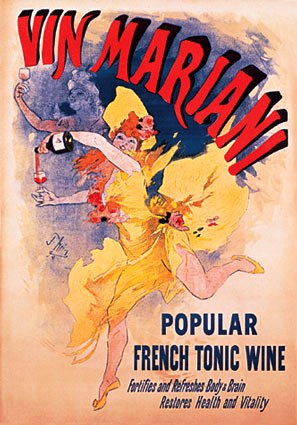

Peugeot Type 3 built in France in 1891.
Peugeot Type 3 Vis à vis (face to face), 1891.- Musée Peugeot de Sochaux



The blue and gold Grand Foyer of the Folies Bergère renovated in 1974 by Helène Martini
The name Belle Époque encompasses the realities of expansion, carefree attitudes, a faith in progress, and an affluence spreading down through society, together with a certain nostalgia. This nostalgia was an embellishing memory of reality coming out of the trauma of the First World War. [Note that the term Belle Epoque was not widely used by the French.]
The social disruption, turmoil and loss of the Great War, caused by the millions of young men sent away from their families and work, never to return, marked Western Europe and its societies. Women having to cope without men and replace them at work resulted in female emancipation and independence, while returning military turned against the almost feudal nature of civilian society.
The Belle Epoque was coined to describe the years of peace and prosperity that marked middle-class life in France, before the Great War changed so much. The name soon spread to include many other countries in the West.
The Bell Epoque had notable features, such as dress, art and, with the optimism generated by a new century, engineering feats and technological progress. Art included painting such as the Impressionists, furniture and architecture, much styled by Art Nouveau and the English Arts and Crafts movement.
Art Nouveau building in Paris by architect Jules Lavirotte, sculptures byJean-François Larrivé (1875–1928).
-VIDEO :Paris de la belle époque (1900) en couleur_playlist.
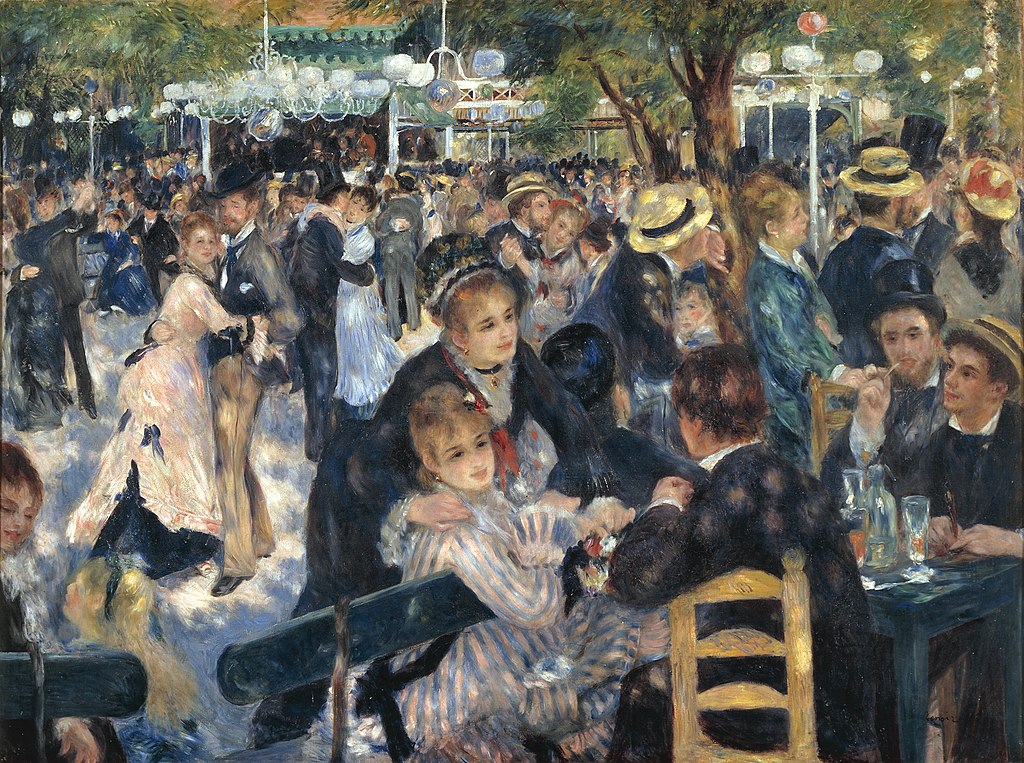

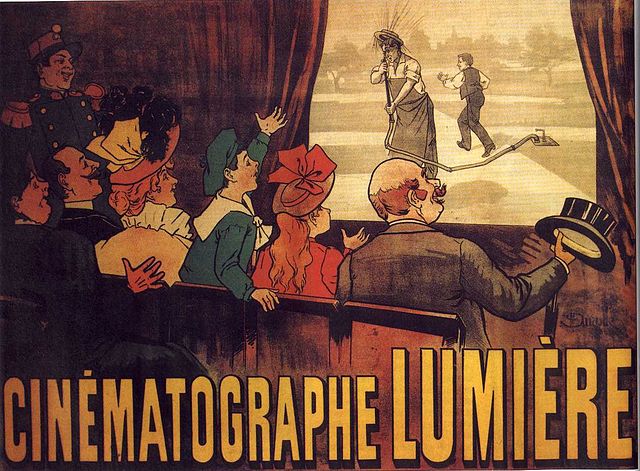
the poster realised as a sand sculpture The poster advertising the Lumière brothers cinematographe, showing a famous comedy (L'Arroseur Arrosé, 1895).
The term Golden Age (Greek: χρύσεον γένος chryseon genos) comes from Greek mythology and legend and refers to the first in a sequence of four or five (or more) Ages of Man, in which the Golden Age is first, followed in sequence, by the Silver, Bronze, Heroic, and then the present (Iron), which is a period of decline, sometimes followed by the Leaden Age. By definition, one is never in the Golden Age.
By extension "Golden Age" denotes a period of primordial peace, harmony, stability, and prosperity. During this age peace and harmony prevailed, did not have to work to feed themselves, for the earth provided food in abundance. They lived to a very old age with a youthful appearance, eventually dying peacefully, with spirit living on as "guardians". Plato in Cratylus (397 e) recounts the golden race of humans who came first. He clarifies that Hesiod did not mean literally made of gold, but good and noble.
There are analogous concepts in the religious and philosophical traditions of the South Asian subcontinent. For example, the Vedic or ancient Hindu culture saw history as cyclical, composed of yugas with alternating Dark and Golden Ages. The Kali yuga (Iron Age), Dwapara yuga (Bronze Age), Treta yuga (Silver Age) and Satya yuga (Golden Age) correspond to the four Greek ages. Similar beliefs occur in the ancient Middle East and throughout the ancient world, as well.
In classical Greek mythology the Golden Age was presided over by the leading Titan Cronus. In some version of the myth Astraea also ruled. She lived with men until the end of the Silver Age, but in the Bronze Age, when men became violent and greedy, fled to the stars, where she appears as the constellation Virgo, holding the scales of Justice, or Libra.
European pastoral literary and iconographic tradition often depicted nymphs and shepherds as living a life of rustic innocence and simplicity, untainted by the corruptions of civilization — a continuation of the Golden Age — set in an idealized Arcadia, a region of Greece that was the abode and center of worship of their tutelary deity, goat-footed Pan, who dwelt among them. This idealized and nostalgic vision of the simple life, however, was sometimes contested and even ridiculed, both in antiquity and later on

Pietro da Cortona, The Golden Age (Fresco, Sala della Stufa, Palazzo Pitti, Florence)

Outside the Tuileries Palace in 1867 during the grand reception given for monarchs visiting the Paris Universal Exposition

Painting of the Grand salle of the Théâtre de l'Académie Royale de Musique, 1864.
The Grand salle of the Royal Academy of Music on rue Le Peletier, during a ballet performance; it was the main opera house of Paris before the completion of the Palais Garnier in 1875.

Phantom Of The Opera - Masquerade :
The Grand Staircase leading to the room, lounges and lobby in 1877 by Louis Beroud _Opera_Garnier

Main facade
The principal facade is on the south side of the building, overlooking the Place de l'Opéra and terminates the perspective along the Avenue de l'Opéra. Fourteen painters, mosaicists and seventy-three sculptors participated in the creation of its ornamentation.
The two gilded figural groups, Charles Gumery's L'Harmonie (Harmony) and La Poésie (Poetry), crown the apexes of the principal facade's left and right avant-corps. They are both made of gilt copper electrotype.
The bases of the two avant-corps are decorated (from left to right) with four major multi-figure groups sculpted by: François Jouffroy (Poetry, also known as Harmony), Jean-Baptiste Claude Eugène Guillaume (Instrumental Music), Jean-Baptiste Carpeaux (The Dance, criticized for indecency), and Jean-Joseph Perraud (Lyrical Drama). The facade also incorporates other work by Gumery, Alexandre Falguière, and others.
Gilded galvanoplastic bronze busts of many of the great composers are located between the columns of the theatre's front façade and depict from left to right: Rossini, Auber, Beethoven, Mozart, Spontini, Meyerbeer, and Halévy. On the left and right lateral returns of the front facade are busts of the librettists Eugène Scribe and Philippe Quinault, respectively.
Stage flytower
The sculptural group Apollo, Poetry, and Music, located at the apex of the south gable of the stage flytower, is the work of Aimé Millet, and the two smaller bronze Pegasus figures at either end of the south gable are by Eugène-Louis Lequesne.
The Palais Garnier is a 1,979-seat opera house, which was built from 1861 to 1875 for the Paris Opera. It was originally called the Salle des Capucines, because of its location on the Boulevard des Capucines in the 9th arrondissement of Paris, but soon became known as the Palais Garnier, in recognition of its opulence and its architect, Charles Garnier. The theatre is also often referred to as the Opéra Garnier and historically was known as the Opéra de Paris or simply the Opéra, as it was the primary home of the Paris Opera and its associated Paris Opera Ballet until 1989, when theOpéra Bastille opened at the Place de la Bastille. The Paris Opera now mainly uses the Palais Garnier for ballet.
The Palais Garnier is "probably the most famous opera house in the world, a symbol of Paris like Notre Dame Cathedral, the Louvre, or the Sacré Coeur Basilica."This is at least partly due to its use as the setting for Gaston Leroux's 1910 novel The Phantom of the Opera and, especially, the novel's subsequent adaptations in films and Andrew Lloyd Webber's popular 1986 musical. Another contributing factor is that among the buildings constructed in Paris during the Second Empire, besides being the most expensive, it has been described as the only one that is "unquestionably a masterpiece of the first rank."This opinion is far from unanimous however: the 20th-century French architect Le Corbusier once described it as "a lying art" and contended that the "Garnier movement is a décor of the grave".
The Palais Garnier also houses the Bibliothèque-Musée de l'Opéra de Paris (Paris Opera Library-Museum). Although the Library-Museum is no longer managed by the Opera and is part of the Bibliothèque nationale de France, the museum is included in unaccompanied tours of the Palais Garnier.
-VIDEO :Palais Garnier/Opera National de Paris Documentary

Bronze busts of Beethoven and Mozart on the front façade
-VIDEO :Opéra National de Paris, Palais Garnier

Apollo, Poetry and Music; Apollo's lyre detail
Apollo, Poetry and Music by Aimé Millet (ca. 1860–1869), viewed from the Eastern side (Rue Halévy). Roof of the Palais Garnier, Paris.


Apollo of the Belvedere,ca. 120–140 CE
Apollo : God of music, poetry, art, oracles, archery, plague, medicine, sun, light and knowledge
Apollo (Attic, Ionic, and Homeric Greek: Ἀπόλλων, Apollōn (GEN Ἀπόλλωνος); Doric: Ἀπέλλων, Apellōn; Arcadocypriot: Ἀπείλων, Apeilōn; Aeolic: Ἄπλουν,Aploun; Latin: Apollō) is one of the most important and complex of the Olympian deities in classical Greek and Roman religion and Greek and Roman mythology. The ideal of the kouros (a beardless, athletic youth), Apollo has been variously recognized as a god of music, truth and prophecy, healing, the sun and light, plague, poetry, and more. Apollo is the son of Zeus and Leto, and has a twin sister, the chaste huntress Artemis. Apollo is known in Greek-influenced Etruscan mythology as Apulu.
As the patron of Delphi (Pythian Apollo), Apollo was an oracular god—the prophetic deity of the Delphic Oracle. Medicine and healing are associated with Apollo, whether through the god himself or mediated through his son Asclepius, yet Apollo was also seen as a god who could bring ill-health and deadly plague. Amongst the god's custodial charges, Apollo became associated with dominion over colonists, and as the patron defender of herds and flocks. As the leader of the Muses(Apollon Musegetes) and director of their choir, Apollo functioned as the patron god of music and poetry. Hermes created the lyre for him, and the instrument became a common attribute of Apollo. Hymns sung to Apollo were called paeans.
In Hellenistic times, especially during the 3rd century BCE, as Apollo Helios he became identified among Greeks with Helios, Titan god of the sun, and his sister Artemis similarly equated with Selene, Titan goddess of the moon. In Latin texts, on the other hand, Joseph Fontenrose declared himself unable to find any conflation of Apollo with Sol among the Augustan poets of the 1st century, not even in the conjurations of Aeneas and Latinus in Aeneid XII (161–215).Apollo and Helios/Sol remained separate beings in literary and mythological texts until the 3rd century CE.

Apollo Victorious over the Python by the Florentine Pietro Francavilla (dated 1591) depicting Apollo's first triumph, when he slew with his bow and arrows the serpent Python, which lies dead at his feet (The Walters Art Museum).


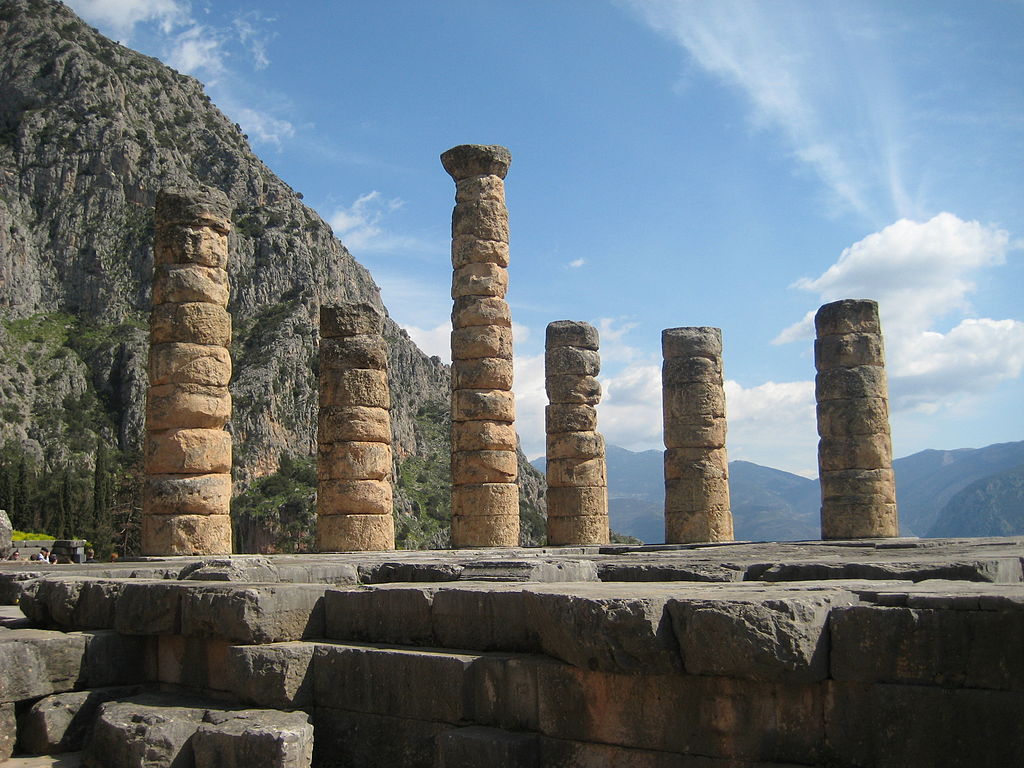

Apollo (left) and Artemis. Brygos (potter signed), tondo of an Attic red-figure cup c. 470 BC, Musée du Louvre.
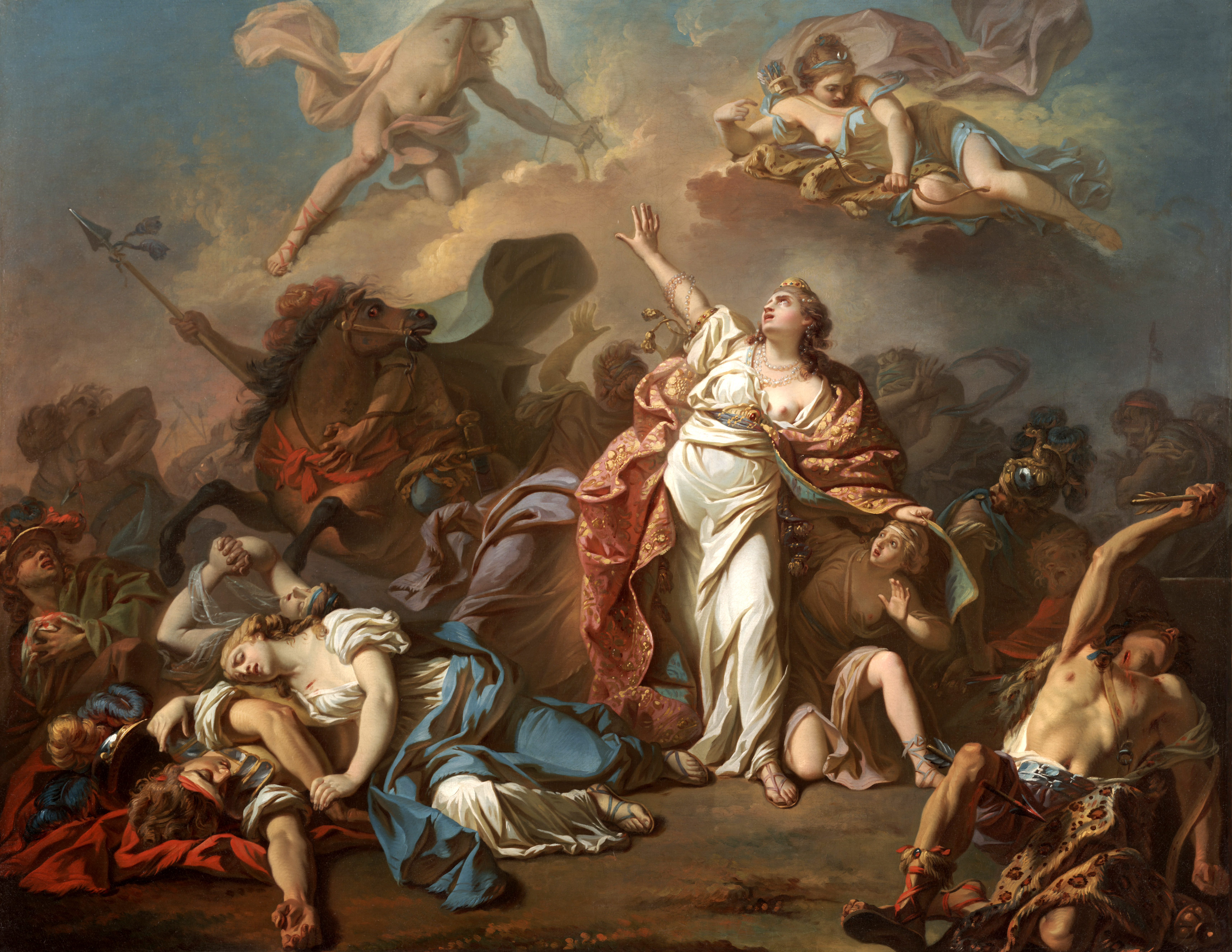
Artemis and Apollo Piercing Niobe's Children with their Arrows by Jacques-Louis David, Dallas Museum of Art
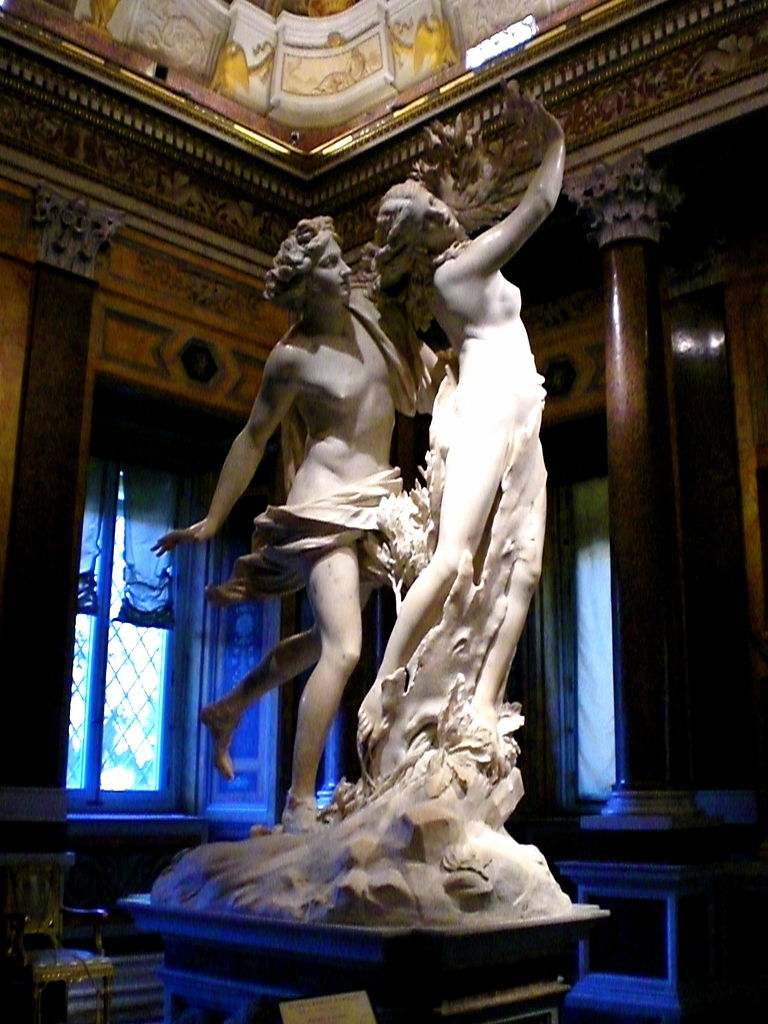

A chariot clock depicting the god Apollo with a lyre (one of his distinctive attributes) leaning against his thigh. Ormolu bronze. France, First Empire/Restoration period.

Head of Apollo, marble, Roman copy of a Greek original of the 4th century BCE, from the collection of Cardinal Albani

Poetry by Charles Gumery (1827–1871). Gilt bronze, H. 7.5 m (24 ft. 7 ¼ in.). Crowning of the façade of the Palais Garnier (right side), Paris

Gumery's L'Harmonie (1869), atop the left avant-corps of the façade, is 7.5 metres (25 ft) of gilt copper electrotype
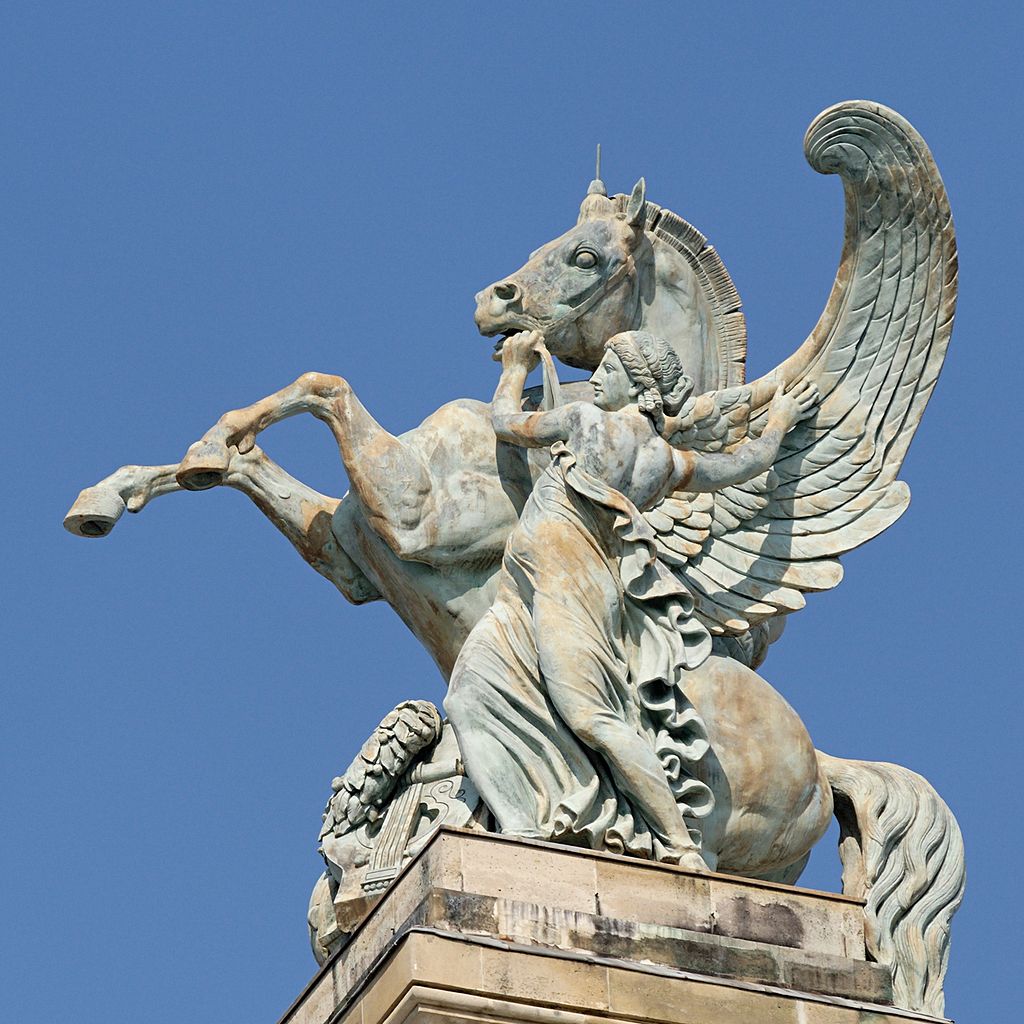
English: Renown holding back Pegasus by Eugène Lequesne (1815–1887). Bronze, southwest corner of the stage flytower roof of the Palais Garnier, Paris. Plaster drafts are exhibited in the Musée d'Orsay.
Français : La Renommée retenant Pégase d'Eugène Lequesne (1815–1887). Tôles de bronze soudées, grand pignon de la scène du Palais Garnier à Paris. Des ébauches en plâtre sont exposées au musée d'Orsay.
A wealth of new and original material highlighting the history and heritage of the Palais Garnier is provided on the site Art project - Google cultural institute by the Paris Opera in partnership with the Google Cultural Institute.
-a virtual tour using Street View technology (as well as providing an original route through the Palais Garnier from the main entrance to the stage and visits to all the different floors of the theatre, the 360°views available with Google Street View provide a unique opportunity to see inside areas traditionally closed to the public like the rooftops, the Ballet rehearsal rooms and the famous lake of the Palais Garnier, the inspiration for Gaston Leroux’s Phantom of the Opera).
-a virtual tour using Street View technology (as well as providing an original route through the Palais Garnier from the main entrance to the stage and visits to all the different floors of the theatre, the 360°views available with Google Street View provide a unique opportunity to see inside areas traditionally closed to the public like the rooftops, the Ballet rehearsal rooms and the famous lake of the Palais Garnier, the inspiration for Gaston Leroux’s Phantom of the Opera).

Lyrical Drama façade sculpture by Jean-Joseph Perraud
Lyric drama by Jean-Joseph Perraud, façade of the Palais Garnier, Paris.

The Dance by Jean-Baptiste Carpeaux
Jean-Baptiste Carpeaux's "La Danse" at the Palais Garnier.
Inside Palais Garnier – The Paris Opera House
Interior
The interior consists of interweaving corridors, stairwells, alcoves and landings allowing the movement of large numbers of people and space for socializing during intermission. Rich with velvet, gold leaf, and cherubim and nymphs, the interior is characteristic of Baroque sumptuousness.
Opera_Garnier_Grand_Escalier.
Grand staircase
The building features a large ceremonial staircase of white marble with a balustrade of red and green marble, which divides into two divergent flights of stairs that lead to the Grand Foyer. Its design was inspired by Victor Louis's grand staircase for the Théâtre de Bordeaux. The pedestals of the staircase are decorated with female torchères, created by Albert-Ernest Carrier-Belleuse. The ceiling above the staircase was painted by Isidore Pils to depict The Triumph of Apollo, The Enchantment of Music Deploying its Charms,Minerva Fighting Brutality Watched by the Gods of Olympus, and The City of Paris Receiving the Plan of the New Opéra. When they were first fixed in place two months before the opening of the building it was obvious to Garnier that they were too dark for the space. With the help of two of his students, Pils had to rework the canvases while they were in place overhead on the ceiling and, at the age of 61, he fell ill. His students had to finish the work, which was completed the day before the opening and the scaffolding was removed.


Welcome to the Masquerade

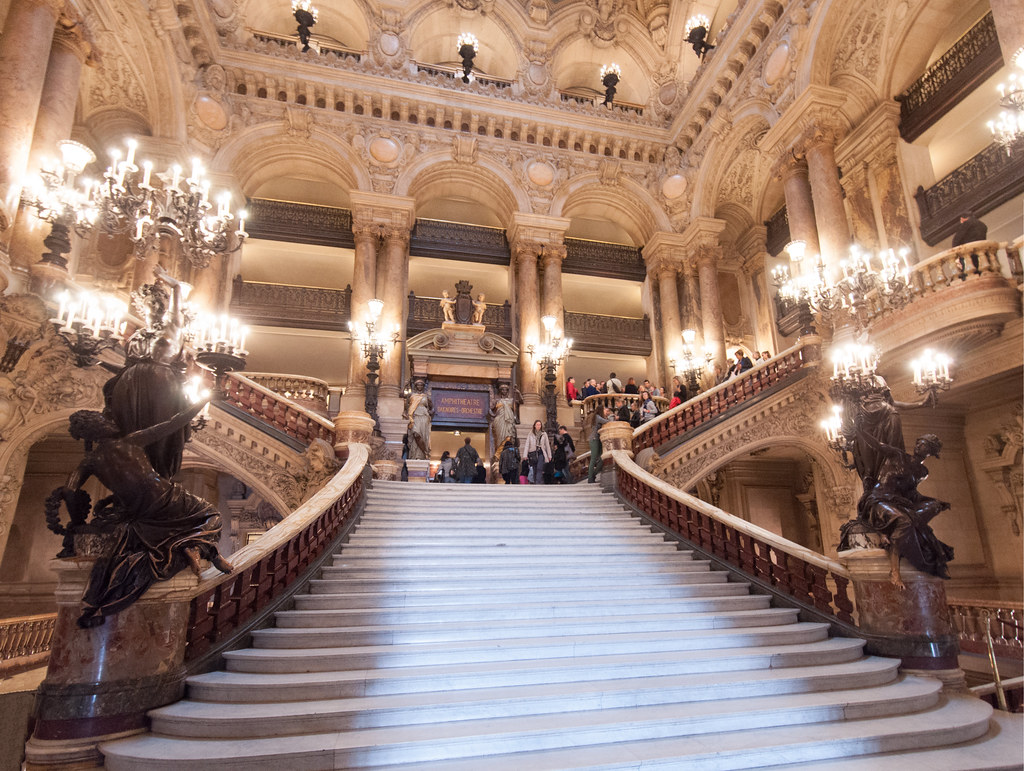

Take a look inside the most famous opera house in the world. The Paris Opera House, Palais Garnier, in Paris, France is known for its opulent Baroque style interior decor and Beaux-Arts exterior architecture.
The construction of the Palais Garnier began in 1861 and was completed in 1875.
Recent restoration of the auditorium includes the ceiling area with a new painting in a modern style by Marc Chagall. At the centre of the painting is the grand chandelier.


Auditorium
The auditorium has a traditional Italian horseshoe shape and can seat 1,979. The stage is the largest in Europe and can accommodate as many as 450 artists. The canvas house curtain was painted to represent a draped curtain, complete with tassels and braid.
The ceiling area, which surrounds the chandelier, was originally painted by Jules Eugène Lenepveu. In 1964 a new ceiling painted by Marc Chagall was installed on a removable frame over the original. It depicts scenes from operas by 14 composers – Mussorgsky, Mozart, Wagner, Berlioz, Rameau, Debussy, Ravel, Stravinsky, Tchaikovsky, Adam, Bizet,Verdi, Beethoven, and Gluck. Although praised by some, others feel Chagall's work creates "a false note in Garnier's carefully orchestrated interior."

The 7-ton bronze and crystal chandelier was designed by Garnier. Jules Corboz prepared the model, and it was cast and chased by Lacarière, Delatour & Cie. The total cost came to 30,000 gold francs. The use of a central chandelier aroused controversy, and it was criticized for obstructing views of the stage by patrons in the fourth level boxes and views of the ceiling painted by Eugène Lenepveu. Garnier had anticipated these disadvantages but provided a lively defense in his 1871 book Le Théâtre: "What else could fill the theatre with such joyous life? Who else could offer the variety of forms that we have in the pattern of the flames, in these groups and tiers of points of light, these wild hues of gold flecked with bright spots, and these crystalline highlights?"
On 20 May 1896, one of the chandelier's counterweights broke free and burst through the ceiling into the auditorium, killing a member of the audience. This incident inspired one of the more famous scenes in Gaston Leroux's classic 1910 gothic novel The Phantom of the Opera.
Originally the chandelier was raised up through the ceiling into the cupola over the auditorium for cleaning, but now it is lowered. The space in the cupola was used in the 1960s for opera rehearsals, and in the 1980s was remodeled into two floors of dance rehearsal space. The lower floor consists of the Salle Nureïev (Nureyev) and the Salle Balanchine, and the upper floor, the Salle Petipa.
 GISELLE | Ballet Palais Garnier Paris
GISELLE | Ballet Palais Garnier Paris
-VIDEO :
Originally the chandelier was raised up through the ceiling into the cupola over the auditorium for cleaning, but now it is lowered. The space in the cupola was used in the 1960s for opera rehearsals, and in the 1980s was remodeled into two floors of dance rehearsal space. The lower floor consists of the Salle Nureïev (Nureyev) and the Salle Balanchine, and the upper floor, the Salle Petipa.

Precious Stones -
The Sleeping Beauty - Paris Opéra Ballet - 2013_- La Belle au Bois Dormant.
Opéra Garnier - le Grand Foyer.
Grand Foyer
This hall 18 meters high, 154 meters long and 13 meters wide was designed to act as a drawing room for Paris society. It was restored in 2004. Its ceiling was painted by Paul-Jacques-Aimé Baudry and represents various moments in the history of music. The foyer opens into an outside loggia at each end of which are the Salon de la Lune and Salon du Soleil.
PARIS. Opéra Garnier. Grand Foyer, salon octogonal est. Peintures ...

On the left is a reproduction of the original ceiling of the Opera. This ceiling is still there a few inches above the new, Chagall one. Perhaps they were worried that the Chagall might give them something a little too daring!
On the right is a portrait of Charles Garnier. 
| On the left is a reproduction of the original ceiling of the Opera. This ceiling is still there a few inches above the new, Chagall one. Perhaps they were worried that the Chagall might give them something a little too daring! On the right is a portrait of Charles Garnier. | ||

Palais Garnier east side with L'Opéra Restaurant
Terrasse Est Opéra Garnier - L'Opéra Restaurant

L'Opéra Restaurant opened in 2011
Restaurant
Garnier had considered installing a restaurant, however for budgetary reasons it was not proceeded with.
After three attempts since 1875, a restaurant was opened on the eastern side of the building in 2011. The L'Opéra Restaurant was designed by French architect Odile Decq. The chef is Christophe Aribert. The restaurant, which has three different spaces and a large outside terrace is accessible to the general public, without the need to buy a ticket to the building or a performance.
-MOVIE :The Phantom of the Opera (2004)

French painter’s James Tissot’s “Hush!” (c.1875), which depicts an elegant French salon.

At about the same time as France was experiencing La Belle Époque, America was going through The Gilded Age, during which many beautiful American works were created. For example, here is Charles Courtney “Curran’s Lotus Lilies” (1888).

Being inspired to create art was not always easy. Here is “The Sleeping Gypsy” (1897) by French artist Henri Rousseau. During his life, Rousseau was laughed at by critics and was very, very poor. But after he died, he was recognized as a self-taught genius. This painting of his has inspired poetry, music, artwork, and TV shows including “The Simpsons.”
Paul Cézanne : Portrait d'Ambroise Vollard, 1899, huile sur toile

Jean Béraud, La sortie des ouvrières de la maison Paquin, rue de la Paix, vers 1902. Huile sur bois
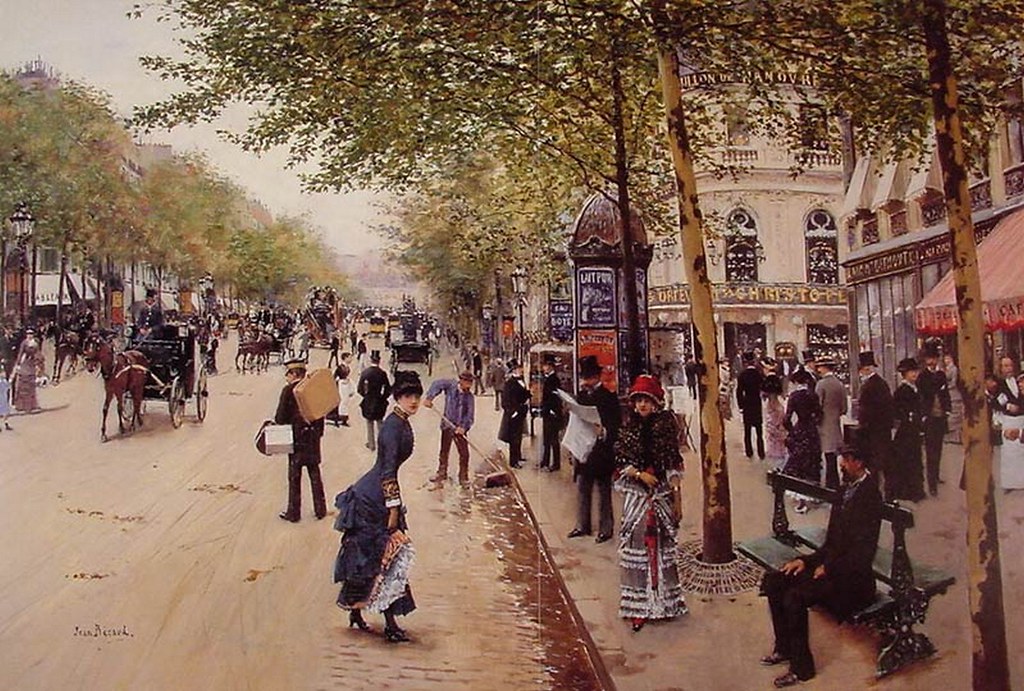
.. Belle époque Paris by Jean Béraud (1889)
Belle Epoque Mode – Artikel von Beata Sievi

eugene galien-laloue (PARISIAN PAINTER )
his photographic portraits of paris he was a documentary artist-painter of the BELLE EPOQUE, showing us one of the world’s most beautiful cities with it’s sidewalks and crowded streets, boulevards and ‘quartiers’.
Jean Béraud (1849 – 1935), peintre du Paris quotidien de la Belle Epoque
jean_beraud__boulevard_des_capucines

World Fair of 1900 in Paris.
Le Château d'eau and plaza, Exposition Universal, 1900, Paris, France
A Trip Through Paris, France in late 1890s / Un voyage à travers Paris, 1890_4K.
-VIEW :the Belle Époque
Belle Époque
La belle époque (The Good Old Days)


The French call it la belle époque -- thegood old days. The thirty years of peace, prosperity, and internal dissension which lie across 1900 wear a bright, almost blatant color. We feel a greater nostalgia looking back that short distance than we do looking back twenty centuries to antiquity. And there is reason. Those years are the lively childhood of our era; already we see their gaiety and sadness transfigured.
For Paris they were the Banquet Years. The banquet had become the supreme rite. The cultural capital of the world, which set fashions in dress, the arts, and the pleasures of life, celebrated its vitality over a long table laden with food and wine. Part of the secret of the period lies no deeper than this surface aspect. Upper-class leisure- the result not of shorter working hours but of no working hours at all for property holders--produced a life of pompous display, frivolity, hypocrisy, cultivated taste, and relaxed morals. The only barrier to rampant adultery was the whalebone corset; many an errant wife, when she returned to face her waiting coachman, had to hide under her coat the bundle of underga1ments which her lover had not been dexterous enough to lace back around her torso. Bourgeois meals reached such proportions that an intermission had to be introduced in the form of a sherbet course between the two fowl dishes. The untaxed rich lived in shameless luxury and systematically brutalized le peuple with venal journalism, inspiring promises of progress and expanding empire, and cheap absinthe.
Jean Beraud, The Wedding Reception (c.1900)
Jean Beraud, The Boulevard Montmartre and the Theatre des Varietes (c1886)
Politics in la belle époque found a surprisingly stable balance between corruption, passion ate conviction, and low comedy. The handsome and popular Prince of Wales neglected the attractions of London to spend his evenings entertaining in Maxim's restaurant, and he did not entirely change his ways upon becoming Edward VII. It was the era of gaslights and horse-drawn omnibuses, of the Moulin Rouge and the Folies Bergère, of cordon-bleu cooking and demonstrating feminists. The waiters in Paris cafes had the courage to strike for the right to grow beards; you were not a man or a republican without one at the turn of the century. Artists sensed that their generation promised both an end and a beginning. No other equally brief period of history has seen the rise and fall of so many schools of cliques and isms. Amid this turmoil, the fashionable salon declined after a last abortive flourishing. The cafe came in to its own, political unrest encouraged innovation in the arts, and society squandered its last vestiges of aristocracy. The twentieth century could not wait fifteen years for a  round number; it was born, yelling, in 1885. It all started with a wake and funeral such as Paris had never staged even for royalty. In May, 1885, four months after an immense state banquet to celebrate his eighty-third birthday, Victor Hugo died. He left the following will: "I give fifty thousand francs to the poor. I desire to be carried to the cemetery in one of their hearses. I refuse the prayers of all churches. I ask for a prayer from all living souls. I believe in God. Four years earlier, during public celebrations of his eightieth year of vigor, the Avenue d'Eylau, where he lived, had been officially renamed in his honor. Now his remains lay in state for twenty-four hours on top of a mammoth urn which filled the Arc de Triomphe and was guarded in half-hour shifts by young children in Grecian vestments. As darkness approached, the festive crowd could no longer contain itself. "The night of May 31, 1885, night of vertiginous dreams, dissolute and pathetic, in which Paris was filled with the aromas of its love for a relic. Perhaps the great city was trying to recover its loss. . . How many women gave themselves to lovers, to strangers, with a burning fury to become mothers of immortals!" What the novelist Barres here describes (in a chapter of Les déracinés entitled "The Public Virtue of a Corpse") happened publicly within a few yards of Hugo's apotheosis. The endless procession across Paris the next day included several brass bands, every political and literary figure of the day, speeches, numerous deaths in the press of the crowd, and final entombment in the Pantheon. The church had to be specially unconsecrated for the occasion. By this orgiastic ceremony France unburdened itself of a man, a literary movement, and a century.
round number; it was born, yelling, in 1885. It all started with a wake and funeral such as Paris had never staged even for royalty. In May, 1885, four months after an immense state banquet to celebrate his eighty-third birthday, Victor Hugo died. He left the following will: "I give fifty thousand francs to the poor. I desire to be carried to the cemetery in one of their hearses. I refuse the prayers of all churches. I ask for a prayer from all living souls. I believe in God. Four years earlier, during public celebrations of his eightieth year of vigor, the Avenue d'Eylau, where he lived, had been officially renamed in his honor. Now his remains lay in state for twenty-four hours on top of a mammoth urn which filled the Arc de Triomphe and was guarded in half-hour shifts by young children in Grecian vestments. As darkness approached, the festive crowd could no longer contain itself. "The night of May 31, 1885, night of vertiginous dreams, dissolute and pathetic, in which Paris was filled with the aromas of its love for a relic. Perhaps the great city was trying to recover its loss. . . How many women gave themselves to lovers, to strangers, with a burning fury to become mothers of immortals!" What the novelist Barres here describes (in a chapter of Les déracinés entitled "The Public Virtue of a Corpse") happened publicly within a few yards of Hugo's apotheosis. The endless procession across Paris the next day included several brass bands, every political and literary figure of the day, speeches, numerous deaths in the press of the crowd, and final entombment in the Pantheon. The church had to be specially unconsecrated for the occasion. By this orgiastic ceremony France unburdened itself of a man, a literary movement, and a century.
-Ella Fitzgerald_ I Love Paris....

City Varieties off Briggate in Leeds, West Yorkshire, UK. Taken on the 2nd May 2009.

Interior of the City Varieties
It was built in 1865 as an adjunct to the White Swan Inn (dating from 1748) in Swan Street and the original interior is largely unaltered. Along with Hoxton Hall and Wilton's Music Hall (both in London), it is a rare surviving example of the Victorian era music halls of the 1850s/1860s. The interior is a long rectangle, with boxes separated by cast-iron columns along the sides at circle level.
The theatre was founded by local pub landlord and benefactor Charles Thornton and was originally called 'Thornton's New Music Hall and Fashionable Lounge'. This followed from a 'Singing Room' above the inn. The name subsequently changed to the White Swan Varieties and then Stansfield's Varieties before becoming the City Palace of Varieties. Charlie Chaplin, Marie Lloyd and Houdini are among the artists who performed there.
Between 1953 and 1983, the theatre achieved national fame as the venue for the BBC television programme The Good Old Days, a recreation of old-time music hall featuringLeonard Sachs as the alliterative Chairman and many well-known and less-well-known performers. The venue still presents live "Good Old Days" music hall events over runs of 3 weekends in the spring and 4 in the autumn, as well as pantomime and a regular programme of stand-up comedy and music concerts.
The City Varieties was granted Heritage Lottery funds to help with major refurbishment and restoration. The theatre closed for refurbishment in January 2009, and re-opened in September 2011. The theatre now seats 467, and the sides of the balcony are closed to the public, now giving space to additional lighting.
The good old days: The story of Britain's music halls
THE story of Britain’s music halls is the story of the birth of variety. In this extract from his book historian Richard Anthony Baker re-tells how they came into being and how the performers were the celebrity icons of their time.
A scene from BBC TV’s The Good Old Days
-VIDEO :Good Old days BBC
The Good Old Days Returns to City Varieties Music Hall
1st October, 2012
Next year it will be 60 years since the world-famous variety show The Good Old Days first aired on the BBC from Leeds’ City Varieties Music Hall.
It was a huge success and ran for 30 years; the audience would dress up in Victorian garb and have a good old-fashioned knees-up and with big name stars such as Les Dawson, Barbara Windsor, Jimmy Tarbuck, Val Doonican and Barry Cryer the show helped to put Leeds on the world map.
The City Varieties still hosts The Good Old Days and next week it returns to start its four-weekend run bringing a host of acts that make it the legendary Music Hall experience it is famous for.
Johnny Dennis is the long-standing Chairman who introduces every show, a role he has undertaken since 1988. “Leeds is my second home,” says the Londoner. “It continues to be a real privilege to perform at the City Varieties and keep the flame of Music Hall alive. We have put together a wonderful group of people who are all excellent at what they do – we have some real talent on that stage.”
Johnny took part in several of the BBC programmes as one of Barney’s Players who performed at the beginning and end of every show.
“We still have Barney’s Players,” continues Johnny. “Today they are Performing Arts students at SLP College in Garforth, Leeds which is wonderful; such a marvellous opportunity for young people to perform on a world-class stage.”
The City Varieties still hosts The Good Old Days and next week it returns to start its four-weekend run bringing a host of acts that make it the legendary Music Hall experience it is famous for.
Johnny Dennis is the long-standing Chairman who introduces every show, a role he has undertaken since 1988. “Leeds is my second home,” says the Londoner. “It continues to be a real privilege to perform at the City Varieties and keep the flame of Music Hall alive. We have put together a wonderful group of people who are all excellent at what they do – we have some real talent on that stage.”
Johnny took part in several of the BBC programmes as one of Barney’s Players who performed at the beginning and end of every show.
“We still have Barney’s Players,” continues Johnny. “Today they are Performing Arts students at SLP College in Garforth, Leeds which is wonderful; such a marvellous opportunity for young people to perform on a world-class stage.”
-VIDEO :Music from the Belle Epoque
The Arts during the Second Empire - the Paris Salon
During the Second Empire, the Paris Salon was the most important event of the year for painters, engravers and sculptors. It was held every two years until 1861, and every year thereafter, in the palais de l’Industrie, a gigantic exhibit hall built for the Paris Universal Exposition of 1855. A medal from the Salon assured an artist of commissions from wealthy patrons or from the French government. Following rules of the Academy of Fine Arts established in the 18th century, a hierarchy of genres of paintings was followed: the highest level was the history painting, followed by the portrait, then the landscape, then the ‘genre’ painting, with the still life at the bottom. Painters devoted great effort and intrigue to win approval from the jury to present their paintings at the Salon, and to have a good place in the exhibit halls.
The Paris Salon was directed by the comte de Nieuwerkerke, the Superintendent of Fine Arts, who was known for his conservative tastes. He was scornful of the new school of realist painters led by Gustave Courbet. One of the most successful Salon artists was Alexandre Cabanel who produced a famous full-length portrait of Napoleon III, and a painting of “The Birth of Venus” which was purchased by the Emperor at the Salon of 1863. Other successful academic painters of the Second Empire were Jean-Louis-Ernest Meissonier, Jean-Léon Gérôme, and Bouguereau

"The Birth of Venus", by Alexandre Cabanel, was purchased by Napoleon III at the Paris Salon of 1863
"Napoleon I in 1814", a portrait of Napoleon III's uncle, by Jean-Louis-Ernest Meissonier. Meissonier was a specialist in portraits and history paintings.
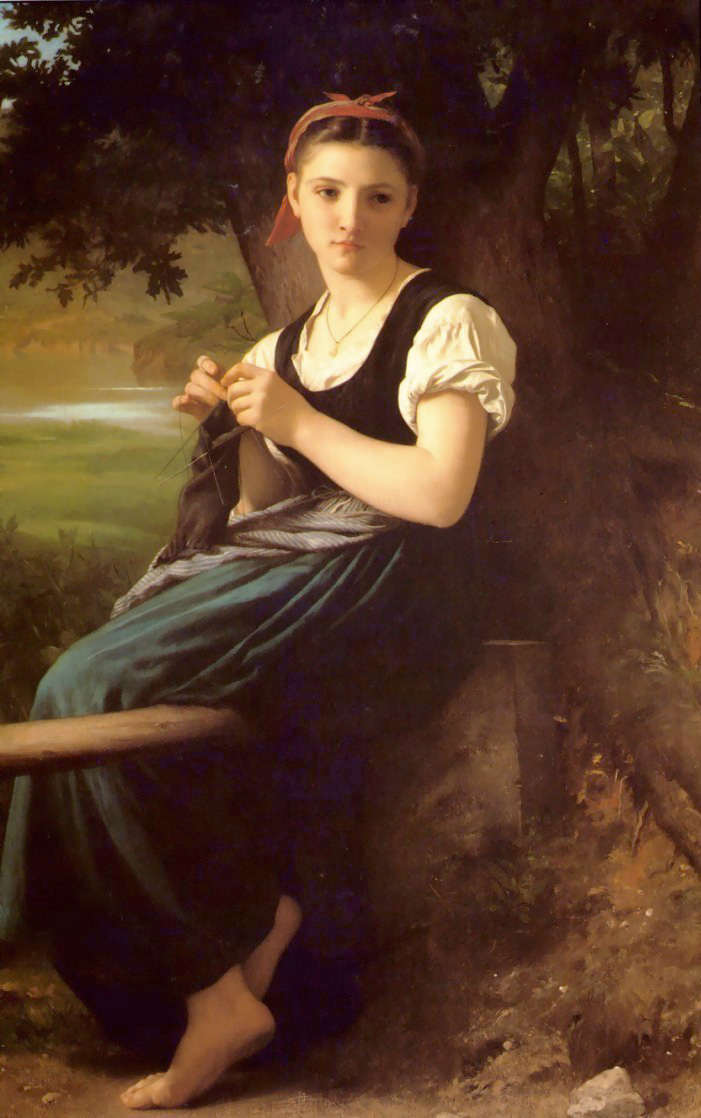
"The Knitting Woman" by William-Adolphe Bouguereau, a very successful academic genre painter.

The Abduction of Rebecca (1858) by Eugène Delacroix, the leader of the romantic school of painting. His studio was on Place Furstenberg, near the Church of Saint-Germain-des-Pres.
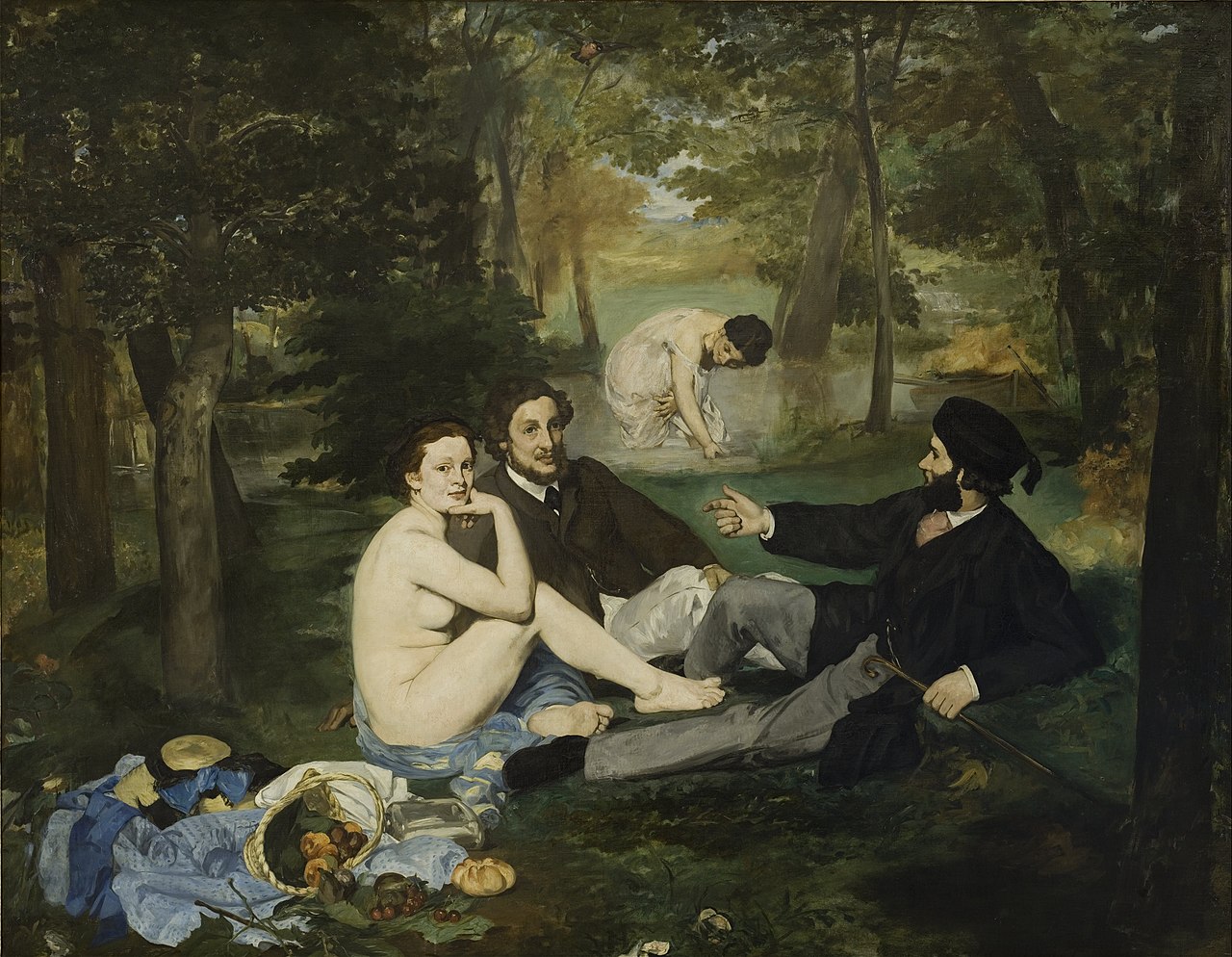
'Luncheon on the Grass' by Edouard Manet caused a scandal at the Paris Salon of 1863, and helped make Manet famous.

Before the term Impressionist was invented, Claude Monet exhibited a portrait of his future wife, Camille Doncieux, at the Paris Salon of 1866, under the title "Woman in a green dress.

La Grenouillére by Pierre-Auguste Renoir. Renoir studied art in Paris in 1862, and placed a painting in the Paris Salon of 1864.

The Empress Eugenie (center, in green) in 1855, surrounded by her ladies in waiting, painted by her favourite artist, Franz Xaver Winterhalter. She set the style of wearing the enormous bell-shaped crinoline.
-MOVIE :The Seven Year Itch (1955)_7 Năm Ngứa Ngáy (Vietsub)
-16 July 2011_Visitors to Chicago’s Magnificent Mile have a choice – to peek or not to peek. A 26 foot sculpture of Marilyn Monroe in that pose was unveiled yesterday. No guessing what a large number chose to do!
Forever Marilyn is a giant statue of Marilyn Monroe designed by Seward Johnson. The statue is a representation of one of the most famous images of Monroe, taken from the 1955 film The Seven Year Itch. Created in July 2011, the statue has been displayed in a variety of locations in the United States as well as in Australia.
-VIEW :Forever Marilyn Unveiled in Chicago_16 July 2011
_film_poster.jpg)
-MOVIE :Gentlemen Prefer Blondes (1953)_QUÝ CÔ TÓC VÀNG (Vietsub)
-MOVIE :Greenwich Village (1944) full movie

-MOVIE :Hugo (2011)_CUỘC PHIÊU LƯU CỦA HUGO (Vietsub)
Set in 1930s Paris, an orphan who lives in the walls of a train station is wrapped up in a mystery involving his late father and an automaton.

-VIDEO :Avanscena - Jewish Dance_Playlist

{fr|Grand sceau de la République Française}}
{{en|The Great Seal of the French Republic


-View : My visit to PARIS_FRANCE_










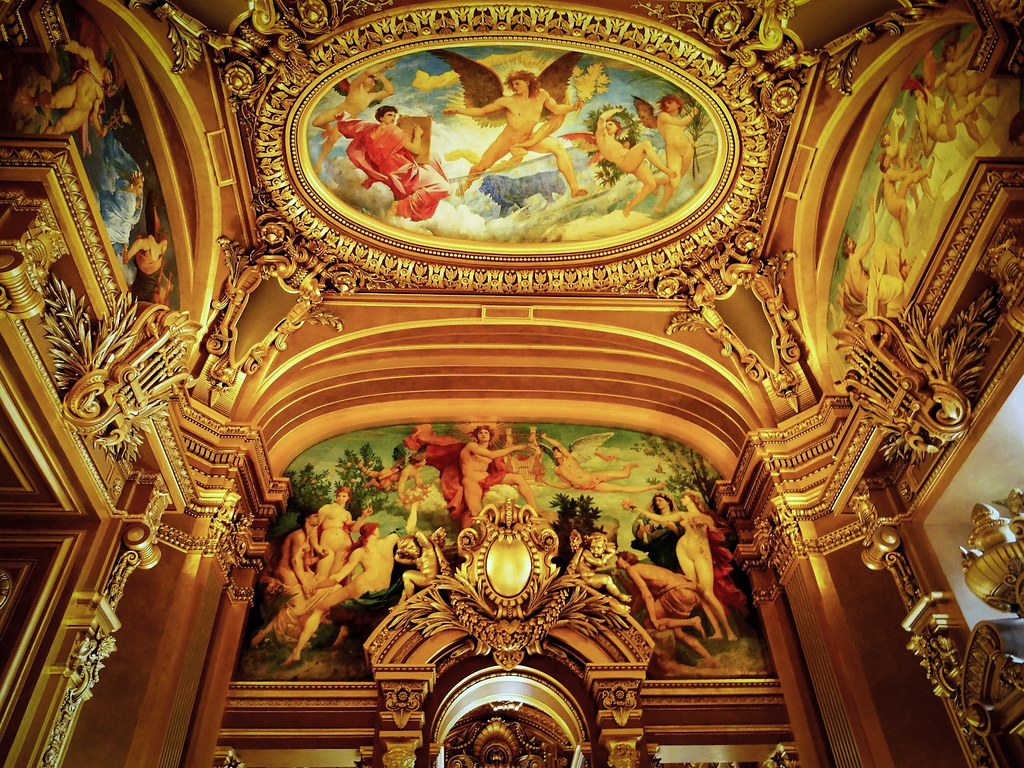



No comments:
Post a Comment